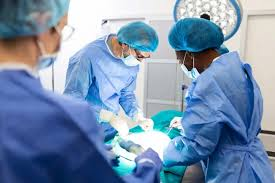What is Hysterolaparoscopy? Here’s A Clear Explanation
When it comes to women’s health, many problems often go unnoticed for too long, not because they aren’t serious, but because they are silent. Issues like unexplained pain, trouble getting pregnant, or irregular periods often don’t show up in basic tests. That’s where a slightly unfamiliar but very important test comes in—hysterolaparoscopy.

Now, we know it’s a big word. Hard to pronounce, a little scary even. But don’t worry — in this blog, we’ll break it down in the simplest way possible. You’ll understand what hysterolaparoscopy is, when it’s needed, how it’s done, and why it matters for so many women.
Let’s start from the beginning.
What Is Hysterolaparoscopy?
Imagine your doctor wants to take a clear look inside your uterus and abdomen — not just through ultrasound or scans, but directly. Hysterolaparoscopy is a procedure that allows them to do exactly that.
The term is actually a combination of two procedures done together:
- Hysteroscopy—to check the uterus (the womb) from the inside.
- Laparoscopy—Laparoscopy is used to take a close look at the organs inside the lower abdomen, such as the ovaries and fallopian tubes.
So, hysterolaparoscopy is like a full inspection of a woman’s reproductive system — inside and out — to find the exact cause of certain health issues.
Why Is It Done?
Let’s say you’ve been trying to get pregnant for a long time, but nothing’s working. Or you’re facing irregular periods, severe cramps, or unusual bleeding. Sometimes, these symptoms don’t show up clearly in blood tests or scans.
That’s when doctors suggest hysterolaparoscopy. It’s one of the best tools to:
- Detect blocked fallopian tubes
- Find fibroids or polyps in the uterus
- To find out if endometriosis is present — a condition where tissue similar to the lining of the uterus starts growing in other parts of the body.
- Look for any infection, cyst, or scar tissue inside
- Spot reasons for repeated miscarriages
- Help with unexplained infertility
Also read: How To Boost Your Fertility For A Successful Pregnancy
In simple words, it answers the “Why? when all other tests leave you without clear answers”.
What Happens During The Test?
Now you might be wondering, “Is it painful?” or “What should I expect?”
Here’s the process in easy terms:

Before the test:
You’ll be given anesthesia so that you don’t feel any pain during the procedure. It’s usually done in a hospital and may require a short stay, sometimes just a few hours.
The procedure:
- The doctor gently passes a thin camera (a scope) through your vagina into the uterus — this is the hysteroscopy part.
- Another tiny cut is made near your belly button to insert another scope — that’s the laparoscopy part.
- With both these tools, the doctor can see clear images on a screen and detect any problem inside.
After the test:
- You might feel a bit of bloating or mild cramps, but that usually goes away in a day or two.
- You’ll be given instructions about rest, food, and any medication if needed.
Most women recover quickly and feel fine within a few days.
Is It Safe?
Yes, hysterolaparoscopy is considered a very safe procedure. Of course, like any medical test, it comes with some basic risks, like minor infection or discomfort. But these are rare, and your doctor will guide you through everything.
The best part? This one test can give answers to multiple problems, which otherwise stay hidden or take years to diagnose.
Who Needs This Test?
This test is usually recommended if:
- You’ve been hoping to conceive for over a year now, but it still hasn’t happened.
- You’ve had two or more miscarriages
- You have irregular, heavy, or painful periods
- You’ve had previous pelvic infections
- Ultrasounds or other reports are unclear
But remember —don’t panic if your doctor suggests it. It doesn’t mean something is wrong. It just means they want a better look to help you faster and more accurately.
What Makes This Test Special?
Most women are used to doing ultrasounds, blood work, and basic tests, but they don’t always reveal the full picture.
Hysterolaparoscopy shows what other tests can miss.
It’s a one-time test that gives doctors a direct view inside, so they can catch even small issues that might be blocking pregnancy or causing discomfort.
Also, in many cases, if something minor is found (like a small cyst or polyp), the doctor can treat it right there, during the same procedure. That means it doesn’t just help find the problem — in some cases, it can also fix it right then and there.
The Emotional Side Of It
We understand — it’s not easy to say yes to such tests. The name sounds scary, the idea feels heavy, and it’s normal to feel nervous.
But think of it like this: Your body deserves clarity. If something is off, wouldn’t you rather know it and treat it early than keep wondering or suffering silently?
Many women, especially those struggling with fertility or menstrual issues, feel a sense of relief after this test. Not just because they get answers, but because they finally feel understood.
Conclusion
You don’t need to know how to pronounce “hysterolaparoscopy” perfectly. But now you know what it means, why it’s done, and how it can help.
It’s a simple but powerful step towards clarity in women’s health. If your doctor suggests this test, try not to worry. Take the time to ask questions, understand your options, and know that this test could bring you closer to peace, healing, or even parenthood.
Sometimes, the answers we’re looking for aren’t as far as we think — we just need to look a little deeper.







